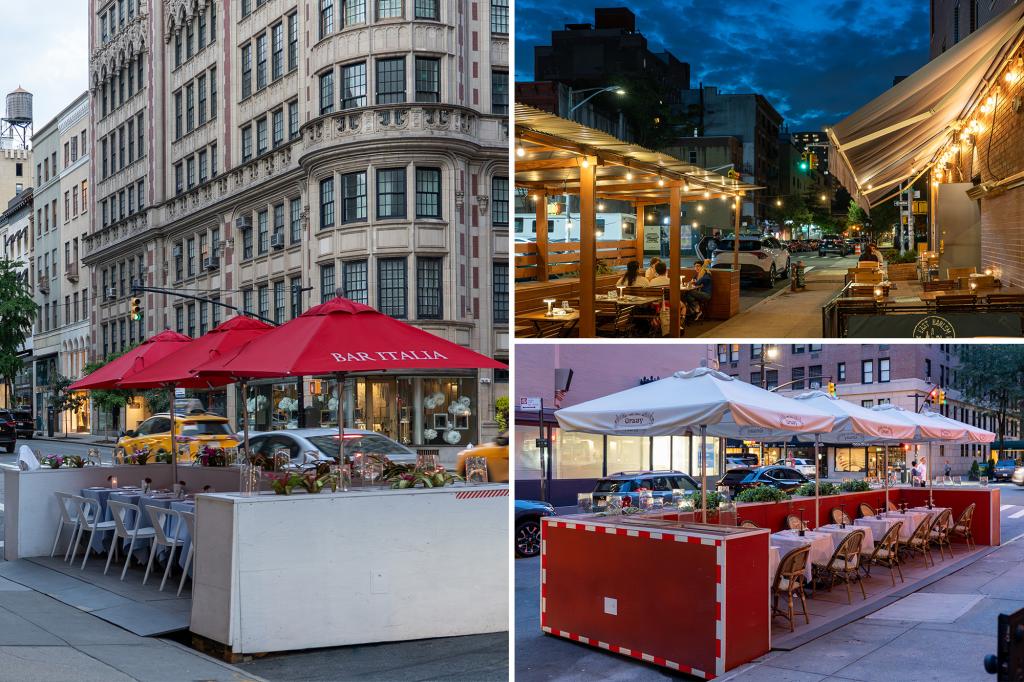NYC’s Curbside Dining Week: Celebrating Outdoor Eateries Amid Post-Pandemic Challenges
New York City is set to launch its inaugural Curbside Dining Week, running from September 5 through September 12, with nearly three dozen restaurants across the boroughs offering exclusive discounts and specials to celebrate outdoor dining culture. “New Yorkers love outdoor dining. We want to showcase that,” explains Jackson Chabot, director of advocacy for OpenPlans, which organized the event in partnership with Untapped New York. The week-long celebration highlights the resilience and adaptability of the city’s restaurant scene, which embraced outdoor spaces as a lifeline during the pandemic. Participating establishments are offering enticing deals to draw patrons to their curbside setups, ranging from percentage discounts off entire bills to special prix fixe menus and complimentary offerings that showcase their culinary creativity and hospitality.
The special offerings across the city reflect the diverse restaurant landscape of New York’s neighborhoods. On the Upper East Side, The Mansion on York Avenue is offering a generous 20% discount on the entire bill, while downtown at Ray’s on Chrystie Street in the Lower East Side, diners can enjoy a 15% reduction. Queens diners can experience a $35 prix fixe menu at Sean Og’s Tavern in Woodside, and Brooklyn patrons at Osteria Radisa in Carroll Gardens will be treated to complimentary house-made limoncello. The Queensboro in Jackson Heights is tempting customers with two-for-one beers and house cocktails, while Someday Bar in Brooklyn’s Boerum Hill neighborhood is serving $3 Dirty Water Hard Seltzer and $3 HOPWATER drinks. Coffee enthusiasts can visit The Barn Coffee Shop in Long Island City, which is offering a 10% discount, and Park Slope’s Postmark Cafe is providing a 15% discount for those who choose to dine in their outdoor space. These promotions not only provide value to customers but also showcase the unique character each establishment brings to their neighborhood’s streetscape.
The evolution of outdoor dining in New York City tells a compelling story of adaptation and resilience. During the height of the COVID-19 pandemic, outdoor dining became a critical survival mechanism for restaurants facing indoor dining restrictions and closures. At its peak, an estimated 12,500 restaurants participated in the Temporary Open Restaurant program, transforming the cityscape with creative outdoor structures that allowed businesses to continue serving customers while maintaining social distancing guidelines. Michael Fuquay, owner of The Queensboro, reflected on this transformation: “When I moved to Jackson Heights 20 years ago, a frequent complaint was the lack of al fresco dining in the area. One of the silver linings of the COVID era was breaking down the administrative barriers to this popular amenity.” For many restaurant owners, these outdoor spaces provided the margin between survival and closure during the most challenging periods of the pandemic, while simultaneously introducing a European-style dining culture that many New Yorkers quickly embraced.
Despite its popularity among restaurant owners and many patrons, the outdoor dining program has faced significant regulatory challenges and community pushback. As the immediate crisis of the pandemic subsided, the City Council implemented new restrictions, and the Department of Transportation issued updated regulations that dramatically reduced participation in the program. Some neighborhood residents voiced concerns about increased trash, vermin, drug use, graffiti, noise, and unpleasant odors associated with some outdoor dining structures. The new regulations include seasonal limitations, permitting outdoor dining only between April 1 and November 29 each year, forcing restaurants to dismantle and store their setups during winter months. This requirement has proven particularly burdensome for small businesses with limited storage capacity. As Fuquay explained, “The New York City Council loaded the new outdoor dining program with exactly the sort of regulatory burdens that prevented outdoor dining before COVID,” adding that the winter storage requirement has “kept most operators out of the program.”
The current state of outdoor dining in New York City represents a significant contraction from its pandemic-era peak. According to the Department of Transportation website, there are now nearly 800 eateries that have received conditional approval or permits under the new regulations—a dramatic decrease from the 12,500 that participated at the height of the Temporary Open Restaurant program. This reduction reflects the challenges many restaurant owners face in navigating the complex and costly new requirements. Megan Rickerson, owner of Someday Bar, expressed hope that Curbside Dining Week would demonstrate “the vibrancy that outdoor dining brings to our neighborhoods and patrons,” and encourage the DOT “to make the process more streamlined and affordable in the future to promote more small bar and restaurant participation.” Similarly, Maria Gonzalez of The Barn Coffee Shop noted that while outdoor dining “became a staple in who we are,” it has “become harder to maintain and keep up with all the changes.”
Beyond the immediate benefits of special promotions and discounts, Curbside Dining Week represents a broader conversation about the future of New York City’s streetscape and the role of outdoor dining in fostering community connections. Brad Canning of Postmark Cafe observed that since adding outdoor seating, “we’ve seen more neighbors stop by, catch up over coffee, and turn our corner into a little community hub.” This sentiment echoes across many participating establishments, which view their outdoor spaces not just as business necessities but as valuable contributions to neighborhood vitality and social cohesion. As the city continues to evolve post-pandemic, the debate over outdoor dining regulations highlights tensions between different visions for urban life—balancing the needs of businesses, residents, pedestrians, and drivers. Curbside Dining Week offers an opportunity to celebrate the positive aspects of outdoor dining culture while acknowledging the ongoing need for thoughtful policy solutions that can sustain this now-beloved feature of New York City’s restaurant scene through all seasons. For restaurant owners and outdoor dining advocates, the hope is that showcasing successful, well-maintained outdoor setups will build public support for a more streamlined, affordable, and accessible program that preserves the community-building benefits of curbside dining spaces.


